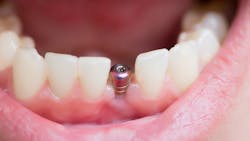Dental implants are the standard of care in replacing missing teeth. The demand for this service continues to rise as the largest segment of our population ages. Traditionally, dental implants were seen as a tooth replacement that would last a lifetime. Although the survival rate of implants is high, a large number may become infected and need treatment. Recognizing these signs of peri-implantitis as early as possible will allow the clinician to treat with the best chance of retaining the implant.
No. 1: Palpate the buccal and lingual aspects of the jaw at the implant site
Many times, exudate will seep out from under the tissue when the jaw is palpated. Not all exudate is a sign of infection. Clear and watery exudate may be due to normal cell sloughing due to a deep crown margin. Dark, thick exudate means there is a problem that needs further inspection.
No. 2: Note radiographic evidence of bone loss
When taking a periapical, different angles may distort the appearance of the bone level. Take both a periapical and bitewing if possible, and count the number of threads that are missing bone to compare to the previous radiograph.
You may also be interested in ...
Inflammation and infection: What's the difference?
No. 3: Record any increase in probing depths
Dental implants should be probed at each recall. If the depth has increased, there may be concern. Keep in mind that probing depth around a dental implant can be healthy at a deeper number; we are looking for changes in depth over time.
No. 4: Observe shiny, red soft tissue
The peri-implant soft tissue may not be obviously inflamed in the same way as it may appear around natural teeth. The signs of inflammation may be subtle.
No. 5: Make patients aware of inflammation
Patients should be unaware of the implant. However, they may become aware of the area when there is inflammation present. They may not describe it as pain, but may suddenly notice their attention goes to the area when eating.
The signs of peri-implantitis may be very subtle and difficult to identify. Clinicians must carefully and fully inspect each implant, take annual radiographs, and keep detailed notes of their findings to be certain the implant remains in good health. If a patient presents with any one of the above warning signs, a referral back to the surgeon who placed the implant may be in order. With careful and diligent care in our offices, coupled with individualized home care, our patients should be able to keep their implants in good health for many years.
Editor's note: Originally published June 24, 2020. Updated February 2023.
About the Author

Nicole Fortune, MBA, RDH
Nicole Fortune, MBA, RDH, is a highly-regarded dental hygienist, educator, and professional speaker who has gained industry-wide recognition for her advanced knowledge of periodontics and peri-implantitis. As a practicing hygienist, Nicole believes the best patient care happens when combining her dental hygiene knowledge with the latest technology. She holds many certifications including CO2, Diode and Nd:Yag laser certification. She is currently the only dental professional in Vermont who is certified in perioscopy. Nicole's dedication to patient care excellence, industry knowledge, and technological acumen earned her the title of Vermont’s Dental Hygienist of the Year for 2017. She is a member of many professional groups, including the Organization for Safety Asepsis and Prevention. She earned her dental hygiene degree at the University of Vermont and holds a MBA from Champlain College.
Updated June 24, 2020
